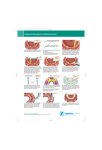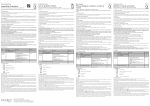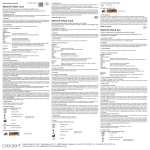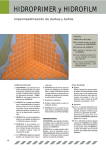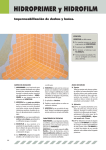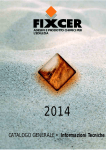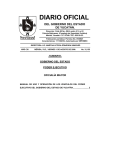Download Instructions for use DI-MUL-04-DSS
Transcript
Custom Abutment for dental implants INSTRUCTIONS FOR USE ENGLISH (INTERNATIONAL) CAUTION – PLEASE READ CAREFULLY DESS LAB® Custom Abutments should only be used by dental specialists with experience in maxillary implantology and other specialities, such as dental diagnosis, planning, dental surgery and CAD prosthetic techniques. If in doubt regarding the product's use, please contact the manufacturer. DESS LAB® Custom Abutments and DESS® screws designed for single-use only must never be re-used. If reused, there is a risk that product damage and deterioration of its characteristics could lead to prosthetic solution failure and / or other deterioration of the patient's health like patient tissue infection. All DESS LAB® Custom Abutments must be dry fitted before use to check the correct fitting. The clinician will be responsible for correct application of those restorative products as planning and procedures are under his/her control. This is the reason why only dental specialists with the appropriate experience and training should work with these products. In case of doubt please contact the manufacturer or your local distributor. U.S. Federal law restricts those devices to sale by or on the order of a licensed dentist / physician. We recommend an annual inspection of the prosthetic restoration by the dentist and the laboratory. This yearly inspection must a screw check. If the screws have suffered unusual wear, the complete integrity of the implant-abutment should be checked. New screws must be used for any revision, correction or replacement. Failure to follow this instruction puts the patient at risk and will void the warranty. During any intraoral use and manipulation all DESS LAB® and DESS® products must be secured to prevent aspiration due to its shape and size. The responsibility for the prosthesis and its construction that will be placed above DESS LAB® Custom Abutment shall lie with the person who has designed the stl file and who will complete the restoration because in any moment there is no way of interfering in abutment design on the part of DESS LAB® employees and the file remains unchanged, neither design validation is proceed. INDICATIONS Custom Implant Abutments are used for prosthetic restorations of dental implants. They are patient-specific product designed by Dental Laboratory using CAD Software. To use this product in digital dentistry DESS® library and scan abutment are needed. To download and install one of our libraries specific to your dental CAD system please visit our website http://www.dess-lab.com/ After registration we will send you a link to download the files. Some dental CAD/CAM systems require a double scan with diagnostical wax-up. If you need additional assistance with installation and/or proper use of the files and with use of piece itself, please contact your DESS® local distributor or find necessary information in corresponding instructions. Designing the abutment follow the recommendations given by your ceramic provider and CAD technique design rules. CONTRAINDICATIONS All materials used are biocompatible; however some patients may present allergies or hypersensitivity to any of the materials and its components (specified in the table). Do not use for restorations with cantilever on a single implant, bruxism or insufficient space. ARTICLE GROUP DESS LAB REF. Nº MATERIAL STERILIZATION RE-USE Co-Cr CUSTOM ABUTMENT 51.0XX-C-XX Cobalt-Chromium-Molybdenum alloy Autoclave before use on the patient Single use TITANIUM CUSTOM ABUTMENT 51.0XX-T-XX Titanium alloy ELI Ti-6Al-4V Autoclave before use on the patient Single use DESS SCREW 19.XXX Titanium alloy ELI Ti-6Al-4V Autoclave before use on the patient Single use COMPATIBILITY INFORMATION All DESS LAB® Custom Abutments are available for a variety of connections. For compatibility with dental implants and implant analogues please visit our website http://www.dess-lab.com or contact your local distributor. STERILIZATION AND RE-USE All products are supplied NON STERILE. For sterilisation, we recommend autoclaving the product at 121°C for 30 minutes, drying time 30 minutes (in accordance with standard UNE-EN ISO 17665-1:2007). They are marked for “Single use only” because it is a custom abutment designed for specific patient. Furthermore, any attempt to reuse a device greatly increases the risk of mechanical failure caused by material fatigue. Any warranty claim resulting from the reuse of a single-use custom device will not be accepted. APPLICATIONS AND DIRECTIONS FOR USE – CoCr CUSTOM ABUTMENT The Co-Cr Custom Abutment is used for prosthetic restorations prepared by dental technicians in the dental laboratory. It is an implant patient-specific device that consists of a mechanized abutment for direct ceramic firing by ceramist. For any laboratory process the abutment must be carefully handCOMPOSITION TECHNICAL DATA tightened into the lab analogue with a lab screw. The existing abutment screw should be used only for the final (percentage by mass) integration of the restoration after being sterilized. Co 65.4 % Yield strength¹ Rp 0.2 > 827 MPa Before ceramic layering remember to clean the structure with vapour and degrease the surface. If sandblasting is Cr 27.75 % Tensile strength¹ Rm > 1172 needed or neck polishing the connection surface needs to be covered with the analogue: this prevents any Mo 5.06 % MPa damage to the settlement part. The veneering should have uniform thickness according to ceramic instructions to Additional elements less than 1 % Hardness¹ HV10 459 prevent cracks and chips. (Fe, Mn, Si, N, Ni, C, Ti, P, S) Fracture elongation¹ A5 21 % Make sure that the engaging parts of the abutment are correctly aligned with the implant retention parts. We strongly recommend Solidus¹ 1369 °C a radiography to verify the correct settlement after tightening. Screw should be fixed with adequate torque according to implant Liquidus¹ 1415 °C connection and size. Sealing of access hole with Teflon tape or gutta-percha and composite is needed. CTE¹ (25 – 500 °C) 14.1 x 10ˉ⁶ Kˉ¹ After placement remember to check static and dynamic occlusion using conventional protocol. Color white ¹ Small variations between batches of sourced raw material are possible. APPLICATIONS AND DIRECTIONS FOR USE – TITANIUM CUSTOM ABUTMENT The Titanium Custom Abutment is used for prosthetic restorations prepared by dental technicians in the dental laboratory. It is an implant patient-specific device that consists of a mechanized abutment forming the core of prosthetic crowns and bridges and used for their support. For any laboratory process the abutment must be carefully hand-tightened into the lab analogue with a lab screw. The existing abutment screw should be used only for the final integration of the restoration after being sterilized. If sandblasting is needed or neck polishing the connection surface needs to be covered with the analogue: this prevents any damage to the settlement part. Make sure that the engaging parts of the abutment are correctly aligned with the implant retention parts and that they are in the correct place and position for all secondary parts. We strongly recommend a radiography to verify the correct settlement after tightening. To improve cement adhesion we recommend that it be thoroughly cleaned and degreased before cementation. You can use any implant luting cement (dual- or self-cured) intra-orally following recommendations of cement manufacturer. Before cementing the final restoration, check the torque according to implant connection and size. When cementing use definitive luting cement or use temporary cement after sealing of access hole with Teflon tape or gutta-percha. Remove cement excess from edge of the crown to avoid peri-implantitis which can lead to implant loss. After cementation remember to check static and dynamic occlusion using conventional protocol. APPLICATIONS AND DIRECTIONS FOR USE – DESS SCREW The screw is for fixing prosthetic restorations and auxiliary abutments over implant or analogue. Make sure to secure the parts with corresponding screw and observe specified torque value placed on the label or ask your local DESS® distributor. You can download torques brochure from http://www.dess-lab.com/downloads. For best results, the following conditions must be meticulously met: Use the suitable model key and size for tightening and unscrewing. If in doubt, check that the next size key does not fit into the seat. The driver should be placed in the longitudinal axle of the prosthesis/implant assembly. A new screw should be used when assembling a prosthesis for the first time and for every checks thereafter. For immediate load prostheses screw manually, avoiding excessive torque, and prevent the implant from turning while screwing. When transferring to the patient, do not use the same screw that was used in the laboratory. Make sure the correct model of screw is used for each case. If you have any doubts about the fit of the screw, consult the local distributor. Position the patient to avoid aspiration in case the screw falls during screwing/unscrewing. DI-MUL-03-DSL 1/8 EXPLANATION OF THE SYMBOLS THAT APPEAR ON THE LABELS All DESS LAB® Custom Abutments are manufactured according to ISO 9001:2008 and ISO 13485:2012. For single use only NON Sterile product Manufacturer information Serial No. Read instructions Reference Patient identification Manufacturer: Terrats Medical SL Avda. La Ferrería, 6208110 – Montcada i Reixac -Barcelona (Spain) Tel + 34 935 646 006. Fax +34 935 647 317 [email protected] 3i® and 3i® Certain®, Miniplant®, MicroMiniplant™ and Osseotite® are registered trademarks of 3i Implant Innovations, USA ASTRA TECH™, OsseoSpeed™, ANKYLOS® C/X, XiVE®, FRIADENT® and UniAbutment® are registered trademarks of DENTSPLY Implants BioHorizons® is a registered trademark of BioHorizons, INC. Brånemark System®, NobelReplace® and Replace Select™, NobelActive™, NobelReplace® CC, NobelSpeedy™ and Multiunit® are registered trademarks of Nobel Biocare AB, Sweden ITI®, Straumann® and synOcta® are registered trademarks of Straumann Holding AG, Switzerland MIS® is a registered trademark of MIS Implant Technologies Ltd. Zimmer Screw-Vent® and SwissPlus® are registered trademarks of Zimmer Dental INC, USA Dyna® is a registered trademark of Dyna Dental Engineering BV Locator® is a registered trademark of Zest Anchors INC. The photographs of the products are for information purposes only. The type, reference and connection of each element should be checked. DESS LAB® Custom Abutments may not be available in your country. These instructions replace all previous editions. For any detailed information about DESS LAB® products please contact your local distributor. DI-MUL-03-DSL 2/8 Aditamento personalizado para implantes dentales INSTRUCCIONES DE USO ESPAÑOL (INTERNACIONAL) PRECAUCIÓN – POR FAVOR LEA ATENTAMENTE Los aditamentos personalizados DESS LAB® solo deben ser usados por profesionales de la odontología, con experiencia en implantología maxilar y sus especialidades, como: diagnosis, planificación, cirugía dental o técnica protésica CAD. En caso de duda rogamos se pongan en contacto con el fabricante. Los aditamentos personalizados DESS LAB® y tornillos DESS® están diseñados para un sólo uso y no deben ser reutilizados. Si se reutilizan, existe el riesgo de que el producto dañado o deteriorado de sus características pueda conllevar insuficiencias en la solución protésica y/u otro tipo de deterioro de la salud del paciente como la infección de los tejidos. Todos los aditamentos personalizados DESS LAB® deben ser probados en seco antes de su colocación en boca para comprobar su correcto ajuste. El responsable único de la correcta instalación de los productos será el clínico, ya que tanto la planificación como los procedimientos están bajo su control. Esta es la razón por la que sólo los especialistas dentales con la experiencia y formación adecuada deben trabajar con dichos productos. En caso de duda, póngase en contacto con el fabricante o con su distribuidor local. La Ley federal de los EE.UU. restringe estos dispositivos para su venta por la orden de un dentista / médico autorizado. Se recomienda una inspección anual de la restauración protésica así como el tornillo de fijación por el dentista y el laboratorio. Si los tornillos han sufrido un desgaste inusual, la integridad completa de la conexión implante-pilar debe ser revisada. Para cualquier revisión, corrección o sustitución deben ser utilizados tornillos nuevos. El incumplimiento de esta instrucción pone al paciente en riesgo y anulará la garantía. Durante cualquier uso intraoral y manipulación todos los productos DESS LAB® y DESS® deben ser asegurados para evitar la aspiración debido a su forma y tamaño. La responsabilidad final de la prótesis y su posterior construcción que sea colocada en los pilares personalizados DESS LAB® recaerá íntegramente en el profesional responsable del diseño stl y que completará la restauración, debido a que en ningún momento los empleados DESS LAB® modifican el diseño de pilar y el archivo permanece sin cambios, tampoco se procederá la validación dicho diseño. INDICACIONES Los aditamentos personalizados tienen como fin la restauración protésica de los implantes dentales. Son un producto hecho a medida para cada paciente, diseñado en el Laboratorio Dental utilizando software CAD. Para utilizar este producto de odontología digital son necesarios los pilares de escaneo y la librería DESS®. Para descargar e instalar una de nuestras librerías específicas para su sistema CAD por favor visite nuestra página web http://www.dess-lab.com/ Tras completar el registro en nuestra web, recibirá un enlace para descargar los archivos. Algunos sistemas CAD/CAM requieren un escaneo doble con encerado diagnóstico. Si necesita asistencia adicional para la instalación y/o el uso adecuado de los archivos o de la pieza en sí, por favor póngase en contacto con su distribuidor local DESS® o encuentra la información necesaria en las correspondientes instrucciones. Al diseñar el pilar seguir las recomendaciones del proveedor de cerámica usada para el recubrimiento y las reglas del diseño CAD. CONTRAINDICACIONES Todos los materiales empleados son biocompatibles; sin embargo, algunos pacientes pueden presentar alergias o hipersensibilidad a cualquiera de los materiales y sus componentes (especificados en la tabla). No utilizar para las restauraciones unitarias con extensiones en un solo implante, pacientes con bruxismo o en casos de insuficiente espacio vertical. ARTÍCULO ADITAMENTO PERSONALIZADO DE Cr-Co ADITAMENTO PERSONALIZADO DE TITANIO TORNILLO DESS Nº REF. GRUPO DESS LAB MATERIAL ESTERILIZACIÓN REUTILIZACIÓN 51.0XX-C-XX Cromo-Cobalto-Molibdeno Autoclave antes de utilizarlo con un paciente Un sólo uso 51.0XX-T-XX Titanio ELI Ti-6Al-4V Autoclave antes de utilizarlo con un paciente Un sólo uso 19.XXX Titanio ELI Ti-6Al-4V Autoclave antes de utilizarlo con un paciente Un sólo uso INFORMACIÓN DE COMPATIBILIDAD Todos los pilares personalizados DESS LAB® están disponibles para una amplia variedad de conexiones. Para la compatibilidad con los implantes dentales y análogos por favor visite nuestra página web http://www.dess-lab.com o póngase en contacto con su distribuidor local. ESTERILIZACIÓN Y REUTILIZACIÓN Todos los productos se suministran NO ESTÉRILES. Para la esterilización se recomienda el tratamiento en autoclave a 121 °C durante 30 minutos, secado 30 minutos (según la norma UNE-EN ISO 17665-1: 2007). Están marcados por "un sólo uso", ya que es un pilar personalizado diseñado para un paciente específico. Además, cualquier intento de reutilizar dicho dispositivo aumenta gravemente el riesgo de fallo mecánico causado por la fatiga del material. No se aceptará ninguna reclamación de garantía resultante de la reutilización de un producto a medida de un sólo uso. APLICACIONES Y MODO DE EMPLEO – ADITAMENTO PERSONALIZADO DE Cr-Co El aditamento personalizado de Cr-Co se utiliza para restauraciones protésicas preparadas por los técnicos dentales en el laboratorio. Es un dispositivo de implantología para un paciente especifico que consiste en un pilar mecanizado para la cocción directa de cerámica por ceramista. El pilar debe estar COMPOSICIÓN DATOS TÉCNICOS cuidadosamente fijado en el análogo y apretado con un tornillo de laboratorio. El tornillo de laboratorio está (porcentaje en masa) diseñado exclusivamente para el procesamiento de laboratorio. El tornillo clínico del conjunto debe ser utilizado sólo para la fijación final de la restauración después de ser esterilizado. Co 65.4 % Límite elástico¹ Rp 0.2 > 827 Antes de proceder a la estratificación de la cerámica recuerde limpiar la estructura con vapor y desengrasar la Cr 27.75 % MPa Mo 5.06 % Resistencia a la tracción¹ Rm > superficie. Si es necesario chorrear el aditamento o pulir el cuello, la parte de la conexión tiene que estar cubierta Elementos adicionales de menos 1172 MPa con el análogo para prevenir daños. La capa de cerámica debe tener un espesor uniforme según las instrucciones de 1 % (Fe, Mn, Si, N, Ni, C, Ti, P, S) Dureza¹ HV10 459 de cerámica para evitar grietas y astillas. Dilatación de rotura¹ A5 21 % Asegúrese de que las partes de acoplamiento del pilar están correctamente alineadas con las partes antirotatorias del implante. Solidus¹ 1369 °C Recomendamos realizar una radiografía periapical para verificar el ajuste correcto después de apretar el tornillo. Dicho tornillo Liquidus¹ 1415 °C debe fijarse con el torque según la conexión y el tamaño del implante. Es importante sellar la chimenea con cinta de teflón o CET¹ (25 – 500 °C) 14.1 x 10ˉ⁶ Kˉ¹ gutapercha y composite. Después de la colocación comprobar la oclusión estática y dinámica usando el protocolo convencional. Color blanco ¹ Referente al lote, los datos indicados pueden variar APLICACIONES Y MODO DE EMPLEO – ADITAMENTO PERSONALIZADO DE TITANIO El aditamento personalizado de titanio se utiliza para restauraciones protésicas preparadas por los técnicos dentales en el laboratorio. Es un dispositivo de implantología para un paciente especifico que consiste en un pilar mecanizado que forma el núcleo de coronas o forma el apoyo de puentes. El pilar debe estar cuidadosamente fijado en el análogo y apretado con un tornillo de laboratorio. El tornillo de laboratorio está diseñado exclusivamente para el procesamiento de laboratorio. El tornillo clínico del conjunto debe ser utilizado sólo para la fijación final de la restauración después de ser esterilizado. Si es necesario chorrear el aditamento o pulir el cuello, la parte de la conexión tiene que estar cubierta con el análogo para prevenir daños. Asegúrese de que las partes de acoplamiento del pilar están correctamente alineadas con las partes antirotatorias del implante y bien posicionadas con las partes secundarias. Recomendamos realizar una radiografía periapical para verificar el ajuste correcto después de apretar el tornillo. Para mejorar la adherencia del cemento se recomienda limpiar y desengrasar las superficies antes de la cementación. Se puede emplear cualquier cemento de implantes (de curado dual o autoadhesivo) para cementar en la boca, según las instrucciones del fabricante del cemento. Antes de cementar la restauración final, comprobar el torque según la conexión y el tamaño del implante. Utilizar cemento definitivo o provisional tras el sellado de la chimenea con cinta de teflón o gutapercha. Limpiar el exceso de cemento en el borde de la corona para evitar la periimplantitis que puede conducir a la pérdida del implante. Después de la cementación recuerde revisar la oclusión estática y dinámica usando el protocolo convencional. APPLICACIONES Y MODO DE EMPLEO – TORNILLO DESS El tornillo sirve para la fijación de prótesis dentales y pilares auxiliares sobre el implante o análogo. Asegúrese de sujetar las piezas con un tornillo correspondiente y observar el valor del torque especificado en la etiqueta o pregunte a su distribuidor DESS®. Puede descargar el folleto de los torques en http://www.dess-abutments.com/downloads. Para obtener los mejores resultados las siguientes condiciones deben ser cumplidas meticulosamente: Para apretar o desatornillar utilice el modelo y tamaño de la llave adecuada. En caso de duda compruebe si la llave de tamaño más grande encaja en el asiento. La punta debe ser colocada en el eje longitudinal del conjunto de prótesis / implante. Es imprescindible usar un tornillo nuevo cuando se monta la prótesis por primera vez como posteriormente en cada revisión de la prótesis. En casos de carga inmediata atornillar manualmente evitando un torque excesivo, y asegurar el implante para que no gire al atornillar. Al transferir al paciente, no poner el mismo tornillo que se utilizó en el laboratorio. Asegúrese de que el tornillo utilizado para el caso es un modelo correcto. Si tiene alguna duda sobre el ajuste del tornillo, consulte al distribuidor local. Coloque el paciente en una postura segura para evitar la aspiración en caso de que el tornillo se caiga durante su manipulación. DI-MUL-03-DSL 3/8 EXPLICACIÓN DE LOS SÍMBOLOS QUE APARECEN EN LAS ETIQUETAS Todos los aditamentos personalizados DESS LAB® han sido fabricados según la norma ISO 9001:2008 e ISO 13485:2012. No reutilizar Producto NO estéril Datos del fabricante Nº de serie Leer instrucciones Referencia Identificación del paciente Fabricante: Terrats Medical SL Avda. La Ferrería, 6208110 – Montcada i Reixac -Barcelona (España) Tel + 34 935 646 006. Fax +34 935 647 317 [email protected] 3i® y 3i® Certain®, Miniplant®, MicroMiniplant® y Osseotite® son marcas registradas de 3i Implant Innovations, USA ASTRA TECH™, OsseoSpeed™, ANKYLOS® C/X, XiVE®, FRIADENT® y UniAbutment® son marcas registradas de DENTSPLY Implants BioHorizons® marca registrada de BioHorizons, INC. Brånemark System®, NobelReplace® and Replace Select™, NobelActive™, NobelReplace® CC, NobelSpeedy™ y Multi-unit® son marcas registradas de Nobel Biocare AB, Sweden ITI®, Straumann® y synOcta® marcas registradas de Straumann Holding AG, Switzerland MIS® marca registrada de MIS Implant Technologies Ltd Zimmer Screw-Vent® y SwissPlus™ son marcas registradas de Zimmer Dental INC, USA Dyna® marca registrada de Dyna Dental Engineering BV Locator® marca registrada de Zest Anchors INC. Las fotografías de los productos son tan sólo con fines de información. Se debe revisar el tipo, la referencia y la conexión de cada elemento. Los aditamentos personalizados DESS LAB® pueden no estar disponibles en su país. Estas instrucciones reemplazan a todas las ediciones anteriores. Para cualquier información detallada sobre los productos DESS LAB® póngase en contacto con su distribuidor local. DI-MUL-03-DSL 4/8 Implantologiczny łącznik indywidualny INSTRUKCJA UŻYTKOWANIA POLSKI WAŻNE – PROSZĘ PRZECZYTAĆ UWAŻNIE Łączniki indywidualne DESS LAB® powinny być używane wyłącznie przez personel dentystyczny z doświadczeniem w implantologii szczękowej oraz innych dziedzinach z tym związanych, jak: diagnostyka dentystyczna, planowanie, chirurgia stomatologiczna i techniki protetyczne CAD. W przypadku wątpliwości dotyczących zastosowania produktu należy skontaktować się z producentem. Łączniki indywidualne DESS LAB® oraz śruby DESS® przeznaczone do jednorazowego użytku nie mogą być używane ponownie. W przypadku reutylizacji istnieje ryzyko uszkodzenia produktu i pogorszenie jego charakterystyki co z kolei może prowadzić do uszkodzenia uzupełnienia protetycznego i / lub innych komplikacji związanych ze zdrowiem pacjenta (jak na przykład infekcja). Wszelkie łączniki indywidualne DESS LAB® powinny zostać sprawdzone na sucho aby upewnić się w ich spasowaniu. Za prawidłowe zastosowanie elementów protetycznych odpowiedzialny jest klinicysta, jako że planowanie oraz wszelkie procedury są pod jej / jego kontrolą. To jeden z powodów dla których wyłącznie specjaliści dentystyczni z odpowiednim doświadczeniem i wiedzą powinni pracować z tymi produktami. W przypadku wątpliwości lub pytań skontaktuj się z producentem lub autoryzowanym dystrybutorem. Prawo federalne Stanów Zjednoczonych dopuszcza sprzedaż produktów opisanych w tej instrukcji wyłącznie licencjonowanym dentystom lub lekarzom bądź na ich zlecenie. Zalecamy coroczną kontrolę uzupełnienia protetycznego przez dentystę i laboratorium. Kontrola ta w szczególności powinna dotyczyć śrub. Jeśli śruby wykazują nadmierne zużycie powinna zostać sprawdzona integralność połączenia implant-łącznik. Przy każdej rewizji, korekcie lub zamianie powinny zostać użyte nowe śruby. Błędy wynikające z nieprzestrzegania tych zaleceń narażają pacjenta na ryzyko i unieważniają gwarancję producenta. Podczas wszelkich manipulacji wewnątrzustnych wszystkie produkty DESS® muszą być zabezpieczone przed ich aspiracją przez pacjenta ze względu na ich kształt i rozmiar. Odpowiedzialność za protezę której komponentem będzie łącznik indywidualny DESS LAB® spoczywa na osobie, która go zaprojektowała i dostarczyła plik stl oraz która dokończy niniejsze uzupełnienie protetyczne, ponieważ pracownicy DESS LAB® Terrats Medical S.L. na żadnym etapie produkcji nie ingerują w projekt łącznika; również sam projekt nie jest kontrolowany. WSKAZANIA Implantologiczne łączniki indywidualne służą do odbudowy protetycznej na implantach dentystycznych. Jest to wyrób medyczny dla specyficznego pacjenta zaprojektowany przez Laboratorium Dentystyczne przy użyciu oprogramowania CAD. Do zastosowania produktu w stomatologii cyfrowej niezbędna jest biblioteka połączeń DESS® oraz odpowiedni scan abutment. Aby pobrać i zainstalować jedną z bibliotek specyficznych dla każdego systemu CAD, zapraszamy na naszą stronę internetową http://www.dess-lab.com/ Po rejestracji prześlemy Państwu link do pobrania plików. Niektóre systemy CAD/CAM wymagają podwójnego skanowania z diagnostycznym wax-upem. Jeśli potrzebują Państwo dodatkowej pomocy w instalacji i/lub właściwym użytkowaniu plików wraz z produktem, prosimy skontaktować się z lokalnym dystrybutorem DESS® lub poszukać niezbędnych informacji w odpowiedniej instrukcji. Przy projektowaniu łącznika należy przestrzegać zaleceń podanych przez producenta posiadanej ceramiki oraz zasad projektowania w technice CAD. OGÓLNE PRZECIWWSKAZANIA Wszystkie użyte materiały są biokompatybilne; jednak u niektórych pacjentów może wystąpić alergia lub nadwrażliwość na jeden z materiałów lub ich składniki (wyszczególnione w tabeli). Nie stosować do mostów jednostronnych (półmostów) protetycznych opartych na jednym implancie (gdzie siły działają dźwigniowo), w przypadkach bruksizmu lub braku miejsca w zgryzie. ARTYKUŁ NR REF. GRUPY DESS LAB MATERIAŁ STERYLIZACJA REUTYLIZACJA ŁĄCZNIK INDYWIDUALNY Z Cr-Co 51.0XX-C-XX Stop chromo-kobalto-molibdenowy W autoklawie przed użyciem u pacjenta Jednorazowego użytku ŁĄCZNIK INDYWIDUALNY Z Ti 51.0XX-T-XX Stop tytanu ELI Ti-6Al-4V W autoklawie przed użyciem u pacjenta Jednorazowego użytku ŚRUBA DESS 19.XXX Stop tytanu ELI Ti-6Al-4V W autoklawie przed użyciem u pacjenta Jednorazowego użytku KOMPATYBILNOŚĆ Wszystkie łączniki indywidualne DESS LAB® są dostępne dla różnych połączeń. Aby dobrać właściwy element odpowiadający połączeniem z implantem oraz repliką prosimy odwiedzić stronę http://www.desslab.com albo skontaktować się z autoryzowanym dystrybutorem. STERYLIZACJA I REUTYLIZACJA Wszystkie produkty są dostarczane jako NIESTERYLNE. Do sterylizacji zalecamy zastosowanie nasyconej pary wodnej pod ciśnieniem w autoklawie w temperaturze 121°C przez 30 minut, suszenie 30 minut (zgodnie ze standardem UNE-EN ISO 17665-1:2007). Elementy te są oznaczone “Wyłącznie do jednorazowego użytku” ponieważ jest to wyrób dla specyficznego pacjenta. Ponadto wszelkie próby regeneracji tych elementów znacząco zwiększają ryzyko uszkodzenia mechanicznego spowodowanego zmęczeniem materiału. Wszelkie roszczenia gwarancyjne wobec produktów regenerowanych nie będą uznawane. ŁĄCZNIK INDYWIDUALNY Z CrCo – ZASTOSOWANIE I WSKAZÓWKI UŻYCIA Łącznik indywidualny z Co-Cr służy do wykonywania uzupełnień protetycznych przez techników dentystycznych w laboratorium. Jest to wyrób medyczny dla specyficznego pacjenta składający się z wyciętego łącznika do bezpośredniego napalania porcelany przez ceramistę. Na każdym etapie laboratoryjnym SKŁAD (procent masowy) DANE TECHNICZNE należy przykręcić łącznik delikatnie do repliki używając śruby laboratoryjnej. Śruba laboratoryjna jest przeznaczona Co 65.4 % Granica plastyczności¹ Rp 0.2 > wyłącznie do użytku na modelu i ostateczne umocowanie pracy w jamie ustnej należy przeprowadzić używając Cr 27.75 % 827 MPa śruby dołączonej w zestawie po uprzedniej sterylizacji. Mo 5.06 % Wytrzymałość na rozciąganie¹ Przed napalaniem ceramiki należy pamiętać, aby oczyścić strukturę przy użyciu pary wodnej i odtłuścić Reszta - mniej niż 1 % (Fe, Mn, Si, Rm > 1172 MPa powierzchnię. Jeśli potrzebne jest piaskowanie łącznika lub polerowanie szyjki, należy zabezpieczyć gniazdo N, Ni, C, Ti, P, S) Twardość¹ HV10 459 przykręcając do łącznika replikę celem jego ochrony. Warstwa licowania powinna mieć jednolitą grubość zgodnie z instrukcją Wydłużenie¹ A5 21 % ceramiki, aby zapobiec pęknięciom i odpryskom. Należy sprawdzić, czy elementy antyrotacyjne łącznika są wyrównane z Solidus¹ 1369 °C elementami antyrotacyjnymi implantu. Zalecana jest kontrola radiologiczna dokładności spasowania łączników z implantami po ich Liquidus¹ 1415 °C Współczynnik rozszerzalności dokręceniu. Śruba powinna być dokręcona momentem obrotowym stosownie do połączenia implantu oraz jego wielkości. Przed cieplnej CTE¹ (25 – 500 °C) 14.1 x zamknięciem kanału śruby kompozytem należy zabezpieczyć śrubę taśmą teflonową lub gutaperką. Zapobiegnie to zablokowaniu 10ˉ⁶ Kˉ¹ śruby w gnieździe oraz zaklejenia jej heksagonu. Po osadzeniu pracy sprawdzić okluzję statyczną i dynamiczną według Kolor biały konwencjonalnych metod. ¹ Możliwe minimalne odchylenia w zależności od serii materiału. ŁĄCZNIK INDYWIDUALNY Z Ti – ZASTOSOWANIE I WSKAZÓWKI UŻYCIA Łącznik indywidualny z Ti służy do wykonywania uzupełnień protetycznych przez techników dentystycznych w laboratorium. Jest to wyrób medyczny dla specyficznego pacjenta składający się z wyciętego łącznika tworzącego filar podbudowy konstrukcji koron i mostów protetycznych łącząc je ze wszczepem. Na każdym etapie laboratoryjnym należy przykręcić łącznik delikatnie do repliki używając śruby laboratoryjnej. Śruba laboratoryjna jest przeznaczona wyłącznie do użytku na modelu i ostateczne umocowanie pracy w jamie ustnej należy przeprowadzić używając śruby dołączonej w zestawie po uprzedniej sterylizacji. Jeśli potrzebne jest piaskowanie łącznika lub polerowanie szyjki, należy zabezpieczyć gniazdo przykręcając do łącznika replikę celem jego ochrony. Należy sprawdzić, czy elementy antyrotacyjne łącznika są wyrównane z elementami antyrotacyjnymi implantu oraz z cementowaną na nim strukturą. Zalecana jest kontrola radiologiczna dokładności spasowania łączników z implantami po ich dokręceniu. Aby poprawić adhezję cementu, zalecamy dokładne oczyszczenie powierzchni klejonych oraz ich odtłuszczenie przed nałożeniem cementu. Można użyć dowolnego cementu lutującego (duo- lub chemoutwardzalnego) do cementacji wewnątrzustnej, według wskazówek producenta cementu. Przed osadzeniem pracy ostatecznej zaleca się kontrolę momentu obrotowego śruby stosownie do połączenia implantu oraz jego wielkości. Przed nałożeniem cementu ostatecznego lub tymczasowego wyblokować otwory śrub taśmą teflonową lub gutaperką. Dokładne usunięcie nadmiarów cementu z brzegu koron zapobiega znacząco wystąpieniu periimplantitis, które jest główną przyczyną utraty wszczepów. Po osadzeniu pracy sprawdzić okluzję statyczną i dynamiczną według konwencjonalnych metod. ŚRUBA DESS – ZASTOSOWANIE I WSKAZÓWKI UŻYCIA Śruba służy do mocowania uzupełnień protetycznych oraz łączników pomocniczych na implancie lub replice. Należy się upewnić że zastosowana śruba odpowiada danemu systemowi i platformie oraz zwrócić uwagę na zalecany moment obrotowy. Moment ten umieszczony jest na etykiecie. W razie wątpliwości skontaktuj się ze swoim autoryzowanym dystrybutorem DESS®. Tabelę z momentami obrotowymi dla poszczególnych śrub można też pobrać ze strony http://www.dess-abutments.com/downloads. Dla uzyskania najlepszych rezultatów należy dokładnie przestrzegać następujących zaleceń: Do wkręcania lub wykręcania śrub stosować klucz o odpowiednim modelu i rozmiarze. W przypadku wątpliwości sprawdzić, czy klucz w większym rozmiarze nie wchodzi do gniazda. Śrubokręt należy umieścić w osi wzdłużnej zespołu implant / łącznik. Zarówno przy zakładaniu protezy po raz pierwszy, jak i w przyszłości należy stosować nowe śruby. Dla protez o natychmiastowym obciążeniu dokręcać ręcznie unikając nadmiernego momentu obrotowego oraz zabezpieczając implant przed jego obracaniem się w trakcie tej czynności. Nie stosować śrub uprzednio używanych w laboratorium do ostatecznego mocowania pracy na implancie. Upewnić się, że dla każdego przypadku stosowany jest właściwy model śruby. W przypadku wątpliwości dotyczącej spasowania śruby należy skontaktować się z oficjalnym dystrybutorem. W czasie jakichkolwiek manipulacji wewnątrzustnych należy ułożyć pacjenta w pozycji zapobiegającej aspiracji śruby w przypadku jej upuszczenia w jamie ustnej. DI-MUL-03-DSL 5/8 OBJAŚNIENIE SYMBOLI WYSTĘPUJĄCYCH NA ETYKIECIE Nie stosować ponownie Produkt niesterylny Dane producenta Nr serii Przeczytaj instrukcję Nr referencyjny Identyfikacja pacjenta Producent: Terrats Medical SL Avda. La Ferrería, 6208110 – Montcada i Reixac -Barcelona (Hiszpania) Tel + 34 935 646 006. Fax +34 935 647 317 [email protected] Wszystkie łączniki indywidualne DESS LAB® wytwarzane są zgodnie z międzynarodowymi normami ISO 9001:2008 i ISO 13485:2012. 3i® oraz 3i® Certain®, Miniplant®, MicroMiniplant® i Osseotite® są zarejestrowanymi znakami towarowymi 3i Implant Innovations, USA ASTRA TECH™, OsseoSpeed™, ANKYLOS® C/X, XiVE®, FRIADENT® i UniAbutment® są zarejestrowanymi znakami towarowymi DENTSPLY Implants BioHorizons® zarejestrowany znak towarowy BioHorizons, INC. Brånemark System®, NobelReplace® i Replace Select™, NobelActive™, NobelReplace® CC, NobelSpeedy™ i Multi-unit®są zarejestrowanymi znakami towarowymi Nobel Biocare AB, Sweden ITI®, Straumann® i synOcta® są zarejestrowanymi znakami towarowymi Straumann Holding AG, Switzerland MIS® zarejestrowany znak towarowy MIS Implant Technologies Ltd Zimmer Screw-Vent™ i SwissPlus™ są zarejestrowanymi znakami towarowymi Zimmer Dental INC, USA Dyna® zarejestrowany znak towarowy Dyna Dental Engineering BV Locator® zarejestrowany znak towarowy Zest Anchors INC Zdjęcia produktów użyte jedynie w celach informacyjnych. Typ, referencja i połączenie każdego elementu powinny być sprawdzone przed każdym użyciem. Łączniki indywidualne DESS LAB® mogą być niedostępne we wszystkich krajach. Ta edycja instrukcji zastępuje wszystkie poprzednie. W celu dodatkowych informacji na temat łączników indywidualnych DESS LAB® skontaktuj się z autoryzowanym dystrybutorem. AUTORYZOWANY DYSTRYBUTOR W POLSCE ROBOCAM ul. Dubois 10/5, 00-188 Warszawa Tel: +48 22 460 42 09, E-mail: [email protected] DI-MUL-03-DSL 6/8 Individuelle Abutments für Zahnimplantate GEBRAUCHSANWEISUNG DEUTSCH VORSICHT – BITTE AUFMERKSAM LESEN DESS LAB® Individuelle Abutments dürfen nur von zahnmedizinischem Fachpersonal, die über ausreichend Erfahrung in der Implantologie im Kieferbereich und den Spezialgebieten der Dentaldiagnose, Planung, Zahnchirurgie und CAD Zahntechnik verfügen, verwendet werden. Wenn Sie im Hinblick auf die Verwendung des Produkts Zweifel haben, wenden Sie sich bitte an den Hersteller. DESS LAB® Individuelle Abutments und DESS® Schrauben, die für den einmaligen Gebrauch bestimmt sind, dürfen unter keinen Umständen wiederverwendet werden. Bei einer Wiederverwendung besteht das Risiko, dass Produktschäden und die Verschlechterung der Produkteigenschaften zum Versagen der prothetischen Lösung und / oder zu einer Verschlechterung des Gesundheitszustands des Patienten, wie beispielsweise zu einer Gewebeinfektion, führen kann. Alle DESS LAB® Individuelle Abutments müssen vor der Anwendung einprobiert werden, um die einwandfreie Passgenauigkeit zu überprüfen. Der Behandler ist für die korrekte Anwendung dieser Zahnersatzprodukte verantwortlich, da sowohl die Planung als auch die Durchführung seiner Kontrolle unterliegen. Darum sollten nur zahnärztliche Spezialisten mit entsprechender Erfahrung und Ausbildung mit diesen Produkten arbeiten. Im Zweifelsfall kontaktieren Sie bitte den Hersteller oder Ihren Fachhändler. Laut US-Bundesgesetz dürfen diese Produkte nur an zugelassene Zahnärzte / Ärzte oder von ihnen beauftragte Personen abgegeben werden. Wir empfehlen eine jährliche Revision der prothetischen Zahnversorgung durch den Zahnarzt und das Dentallabor. Dabei müssen die Schrauben überprüft werden. Wenn die Schrauben eine ungewöhnlich hohe Abnutzung aufweisen, sollte die vollständige Integrität des Implantataufbaus überprüft werden. Für jegliche Art von Revision, Korrektur oder Ersatz müssen neue Schrauben verwendet werden. Die Nichtbeachtung dieser Anweisung gefährdet den Patienten und führt zum Erlöschen der Garantie. Aufgrund ihrer Form und Größe müssen alle DESS® Produkte während jeder intraoralen Anwendung und Handhabung gesichert werden. Die Verantwortung für die Prothese und seine Konstruktion, die über DESS LAB® Individuelle Abutments gestellt werden, liegt bei der Person, die eine STL-Datei entworfen hat und die Restaurierung abschließen wird, da in keinem Moment die Möglichkeit besteht das Abutmentdesign seitens der DESS LAB® Mitarbeiter zu beeinflussen und die Datei unverändert bleibt. Es wird auch keine Konstruktionsprüfung durchgeführt. INDIKATIONEN Individuelle Implantataufbauten werden für prothetische Versorgungen von Zahnimplantaten verwendet. Es handelt sich um patientenspezifische Produkte, die mittels CAD-Software vom Dentallabor entwickelt werden. Um dieses Produkt für die digitale Zahntechnik zu verwenden, benötigen Sie die DESS® Bibliotheken und Scan-Abutments. Um eine unserer zu Ihrem CAD-System passenden Bibliotheken herunterzuladen und zu installieren, besuchen Sie unsere Website unter http://www.dess-lab.com/ Nach der Registrierung senden wir Ihnen einen Link um die Dateien herunterzuladen. Einige dentale CAD/CAM-Systeme erfordern einen Doppelscan mit diagnostischem Wax-up. Wenn Sie weitere Hilfe bei der Installation und/ oder der ordnungsgemäßen Handhabung der Dateien und bei der Verwendung des Einzelstücks selbst benötigen, kontaktieren Sie bitte Ihren lokalen DESS® Händler oder entnehmen Sie die notwendigen Informationen den entsprechenden Gebrauchsanweisungen. Um das Abutment zu entwerfen halten Sie sich an die Anweisungen Ihres Keramikanbieters und die CAD Technik-Design-Vorgaben. ARTIKEL GRUPPE DESS LAB ARTIKEL-NR. MATERIAL STERILISATION WIEDERVERWENDUNG CoCr INDIVIDUELLES ABUTMENT 51.0XX-C-XX Kobalt-Chrom-Molybdän-Legierung im Autoklaven vor Anwendung am Patienten Einmalgebrauch TITANIUM CUSTOM ABUTMENT 51.0XX-T-XX Titanium alloy ELI Ti-6Al-4V im Autoklaven vor Anwendung am Patienten Einmalgebrauch DESS SCREW 19.XXX Titanium alloy ELI Ti-6Al-4V im Autoklaven vor Anwendung am Patienten Einmalgebrauch KONTRAINDIKATIONEN Alle verwendeten Materialien sind biokompatibel; einige Patienten leiden jedoch möglicherweise unter Allergien oder Überempfindlichkeiten gegen eines der (in der Tabelle angegebenen) Materialien und seine Bestandteile. Verwenden Sie die Abutments nicht bei Freiendversorgungen auf Einzelimplantaten, Bruxismus oder ungenügendem Platzangebot. INFORMATION ZUR KOMPATIBILITÄT Alle DESS LAB® Individuelle Abutments sind für eine Vielzahl von Verbindungen erhältlich. Für die Kompatibilität mit Zahnimplantaten und Implantatanalogen konsultieren Sie bitte unsere Webseite http://www.dess-lab.com oder kontaktieren Sie Ihren Fachhändler. STERILISATION UND WIEDERVERWENDUNG Alle Produkte werden UNSTERIL geliefert. Für die Sterilisation empfehlen wir, das Produkt 30 Minuten lang bei 121 °C zu autoklavieren, 30 Minuten Trocknungszeit (gemäß der Norm UNE-EN ISO 17665-1:2007). Die Produkte sind für den einmaligen Gebrauch bestimmt, da es sich um ein Individuelles Abutment handelt, dass speziell für einen bestimmten Patienten entworfen wurde. Darüber hinaus erhöht sich das Risiko eines mechanischen Versagens durch Materialermüdung, wenn versucht wird, ein Produkt wiederzuverwenden. Gewährleistungsansprüche, die aus der Wiederverwendung von Einmalprodukten entstehen, werden nicht übernommen. GEBRAUCHSHINWEISE –INDIVIDUELLES ABUTMENT AUS KOBALT-CHROM Das Individuelle Abutment aus Co-Cr wird für prothetische Versorgungen vom Zahntechniker im Dentallabor verwendet. Es handelt sich um ein Implantat patientenspezifisches Element, das aus einem mechanisch bearbeiteten Aufbau, für Direktkeramikbrand durch den Keramiker, besteht. Während ZUSAMMENSETZUNG TECHNISCHE DATEN jeglicher Laborverarbeitung muss das Abutment vorsichtig mit einer Laborschraube von Hand im Laboranalog (Massenprozentsatz) festgeschraubt werden. Die vorhandene Abutmentschraube darf nur für die endgültige Eingliederung der Co 65.4 % Dehngrenze¹ Rp 0.2 > 827 MPa Restauration verwendet werden, nachdem sie sterilisiert wurde. Cr 27.75 % Zugfestigkeit¹ Rm > 1172 MPa Vor der Keramikschichtung denken Sie daran die Struktur mit Dampf zu reinigen und die Oberfläche zu Mo 5.06 % Härte¹ HV10 459 entfetten Bei Sandbestrahlung oder Polieren des Halsstücks muss die Oberfläche der Verbindung mit dem Weitere Elemente unter 1 % (Fe, Bruchdehnung¹ A5 21 % Laboranalog abgedeckt werden: Dies verhindert eine Beschädigung des Konstruktionsteils. Die Furnier sollte Mn, Si, N, Ni, C, Ti, P, S) Solidustemperatur¹ 1369 °C eine gleichmäßige Dicke übereinstimmend mit den Keramikanweisungen aufweisen, um Risse und Kratzer zu vermeiden. Liquidustemperatur¹ 1415 °C Stellen Sie sicher, dass die ineinandergreifenden Teile des Abutments korrekt mit den Retentionsteilen des Implantats WAK¹ (25 – 500 °C) 14.1 x 10ˉ⁶ Kˉ¹ ausgerichtet sind und dass sich diese Teile an der richtigen Stelle und Position für alle Sekundärteile befinden. Wir empfehlen Farbe weiß dringend eine Radiografie durchzuführen, um eine korrekte Ausführung der Zahnversorgung nach dem Festziehen der Schraube nachzuprüfen. Überprüfen Sie vor dem Zementieren der definitiven Versorgung das Drehmoment gemäß Implantatverbindung und –größe. Verwenden Sie bei der Zementierung definitiven Befestigungszement oder provisorischen Zement, nachdem die Zugangsöffnung mit Teflonband oder Guttapercha versiegelt wurde. Denken Sie nach der Zementierung daran, die statische und dynamische Okklusion nach dem üblichen Protokoll zu überprüfen. ¹ Abweichungen von angegebenen Werten möglich; abhängig von der Charge. GEBRAUCHSHINWEISE – INDIVIDUELLES ABUTMENT AUS TITAN Das Individuelle Abutment aus Titan wird für prothetische Versorgungen vom Zahntechniker im Dentallabor verwendet. Es handelt sich um ein Implantat patientenspezifisches Element, das aus einem mechanisch bearbeiteten Aufbau besteht, der den Kern der Zahnkrone und –brücke bildet und als Stütze dient. Während jeglicher Laborverarbeitung muss das Abutment vorsichtig mit einer Laborschraube von Hand im Laboranalog festgeschraubt werden. Die vorhandene Abutmentschraube darf nur für die endgültige Eingliederung der Restauration verwendet werden, nachdem sie sterilisiert wurde. Bei Sandbestrahlung oder Polieren des Halsstücks muss die Oberfläche der Verbindung mit dem Laboranalog abgedeckt werden: Dies verhindert eine Beschädigung des Konstruktionsteils. Stellen Sie sicher, dass die ineinandergreifenden Teile des Abutments korrekt mit den Retentionsteilen des Implantats ausgerichtet sind und dass sich diese Teile an der richtigen Stelle und Position für alle Sekundärteile befinden. Wir empfehlen dringend eine Radiografie durchzuführen, um eine korrekte Ausführung der Zahnversorgung nach dem Festziehen der Schraube nachzuprüfen. Zur Verbesserung der Zementhaftung empfehlen wir eine gründliche Reinigung und Entfettung vor der Zementierung. Sie können jeden beliebigen (dual- oder chemisch härtenden) Implantatbefestigungszement extraoral verwenden, wobei die Anwendungsempfehlungen des Zementherstellers zu beachten sind. Überprüfen Sie vor dem Zementieren der definitiven Versorgung das Drehmoment gemäß Implantatverbindung und –größe. Verwenden Sie bei der Zementierung definitiven Befestigungszement oder provisorischen Zement, nachdem die Zugangsöffnung mit Teflonband oder Guttapercha versiegelt wurde. Entfernen Sie überschüssigen Zement vom Kronenrand, um eine Periimplantitis zu vermeiden, die zu einem Implantatverlust führen kann. Denken Sie nach der Zementierung daran, die statische und dynamische Okklusion nach dem üblichen Protokoll zu überprüfen. DI-MUL-03-DSL 7/8 GEBRAUCHSHINWEISE – ABUTMENTSCHRAUBE Die Abutmentschraube dient zur Befestigung von prothetischen Versorgungen und Hilfsabutments über dem Zahnimplantat oder dem Laboranalog. Achten Sie darauf, dass die Teile mit den entsprechenden Schrauben befestigt sind und der Drehmomentwert eingehalten wird, der auf dem Produktetikett angegeben ist oder fragen Sie Ihren DESS® Händler. Sie können unsere Drehmomentbroschüre von unserer Webseite unter http://www.dess-lab.com/downloads herunterladen. Die besten Ergebnisse werden erzielt, wenn die folgenden Bedingungen sorgfältig eingehalten werden: Verwenden Sie den in Art und Größe passenden Schraubendreher zum Festziehen und Lösen. Im Zweifelsfall überprüfen Sie, ob die nächste Schlüsselgröße nicht in den Sitz passt. Das Werkzeug sollte in der Längsachse der Prothese/ Implantatanordnung platziert werden. Bei der Erstmontage einer Prothese und danach bei allen weiteren Kontrollen sollte eine neue Schraube verwendet werden. Zur sofortigen Belastung der Prothese ist die Schraube manuell festzuziehen, wobei ein übermäßiges Drehmoment zu vermeiden ist, und zu verhindern, dass das Implantat sich beim Einschrauben dreht. Bei der Übertragung auf den Patienten darf nicht dieselbe Schraube verwendet werden, die im Labor verwendet wurde. Achten Sie darauf, für jeden klinischen Fall das richtige Schraubenmodell zu verwenden. Bei Zweifeln an der Passgenauigkeit der Schraube wenden Sie sich an Ihren Fachhändler. Der Patient ist so zu positionieren, dass eine Aspiration vermieden wird, falls die Schraube beim Festziehen / Lösen herunterfällt. ERKLÄRUNG DER SYMBOLE AUF DEN PRODUKTETIKETTEN Alle DESS LAB® Individuelle Abutments sind hergestellt nach ISO 9001:2008 und ISO 13.485:2012. Nicht zur Wiederverwendung Unsteril Hersteller Chargenbezeichnung Gebrauchsanweisung beachten Artikelnummer Patientenkennzeichnung Hersteller: Terrats Medical SL Avda. La Ferrería, 6208110 – Montcada i Reixac -Barcelona (Spanien) Tel + 34 935 646 006. Fax +34 935 647 317 [email protected] 3i® und 3i® Certain®, Miniplant®, MicroMiniplant™ und Osseotite® sind registrierte Handelsmarken von 3i Implant Innovations, USA ASTRA TECH™, OsseoSpeed™, ANKYLOS® C/X, XiVE®, FRIADENT® und UniAbutment® sind registrierte Handelsmarken von DENTSPLY Implants BioHorizons® ist eine registrierte Handelsmarke von BioHorizons, INC. Brånemark System®, NobelReplace® und Replace Select™, NobelActive™, NobelReplace® CC, NobelSpeedy™ und Multi-unit® sind registrierte Handelsmarken von Nobel Biocare AB, Schweden ITI®, Straumann® und synOcta® sind registrierte Handelsmarken von Straumann Holding AG, Schweiz MIS® ist eine registrierte Handelsmarke von MIS Implant Technologies Ltd. Zimmer Screw-Vent® und SwissPlus® sind registrierte Handelsmarken von Zimmer Dental INC, USA Dyna® ist eine registrierte Handelsmarke von Dyna Dental Engineering BV Locator® ist eine registrierte Handelsmarke von Zest Anchors INC. Die Abbildungen der Produkte dienen lediglich zu Informationszwecken. Typ, Artikelnummer und Verbindung von jedem Produkt müssen überprüft werden. DESS LAB® Individuelle Abutments sind möglicherweise nicht in Ihrem Land erhältlich. Diese Gebrauchsanweisung ersetzt alle vorherigen Ausgaben. Um weitere Information über DESS LAB® Produkte zu erhalten, kontaktieren Sie bitte Ihren Fachhändler. DI-MUL-03-DSL 8/8








